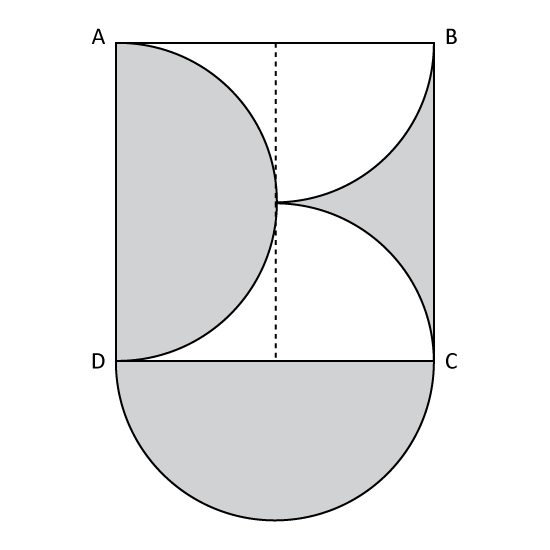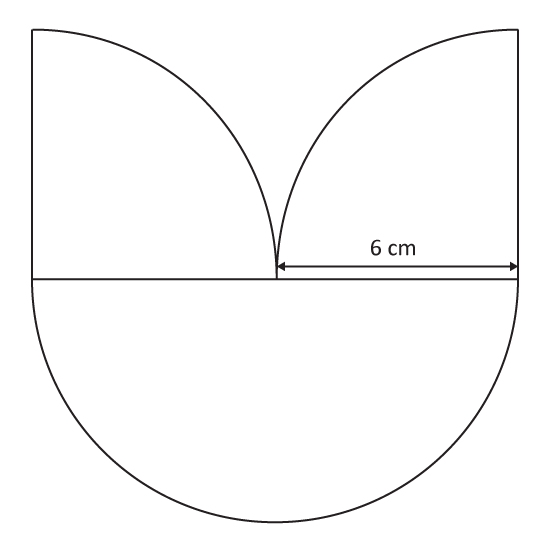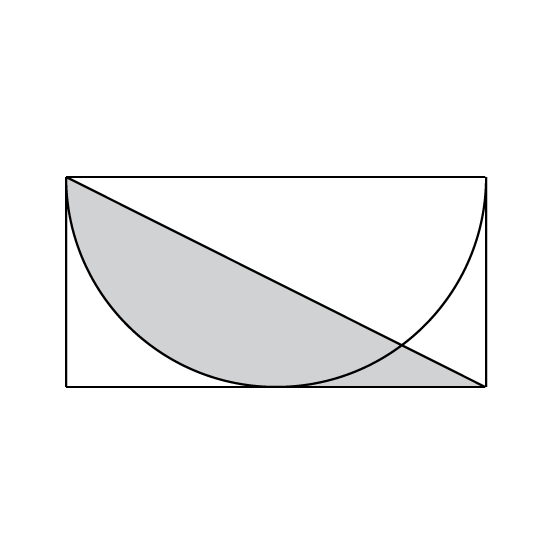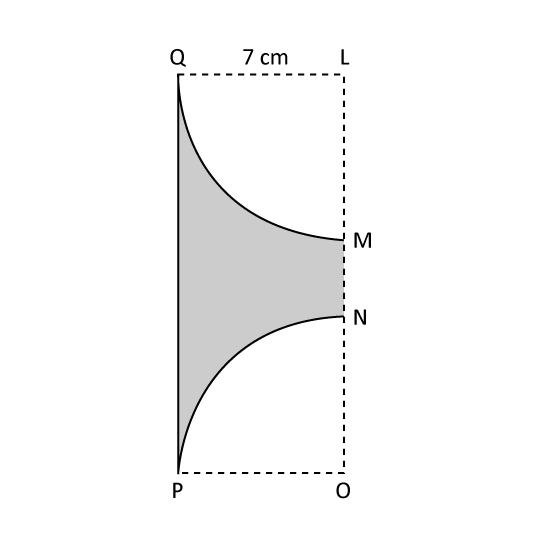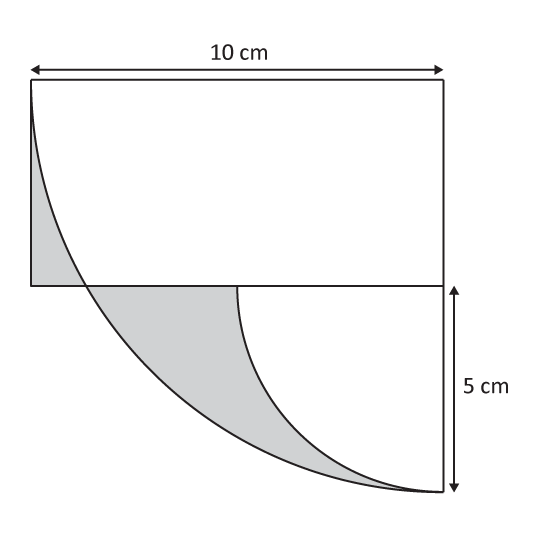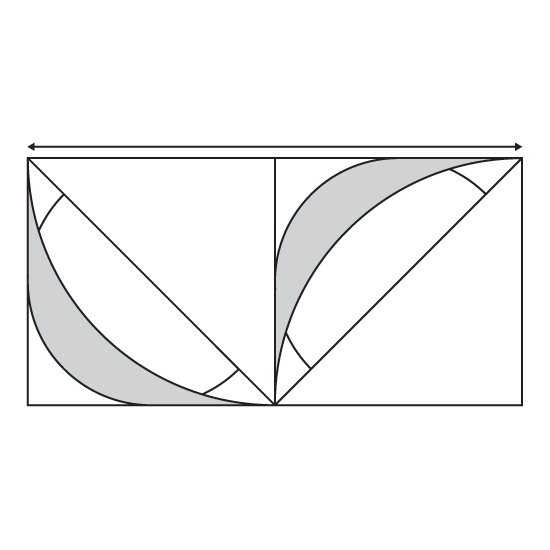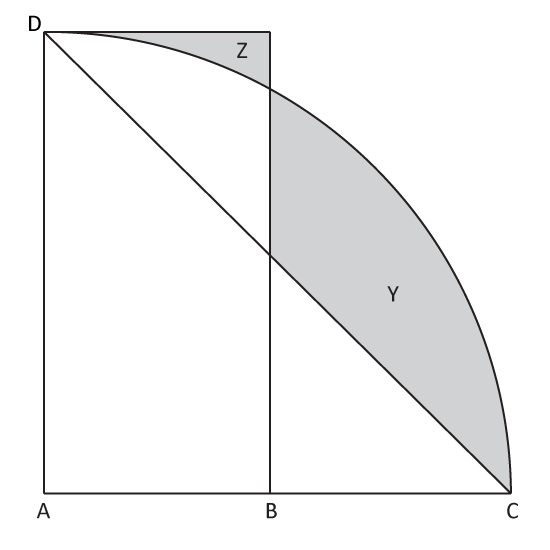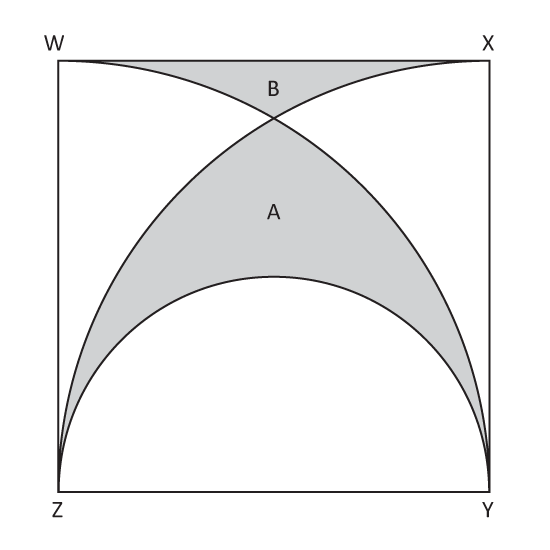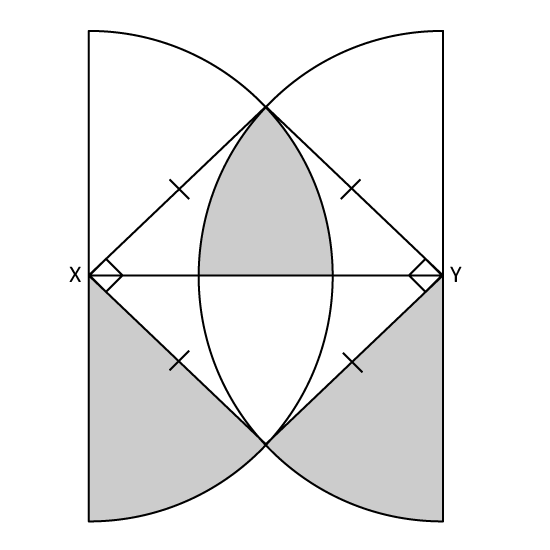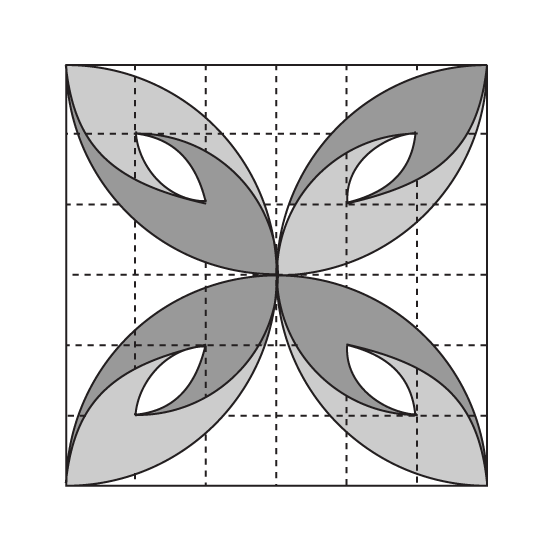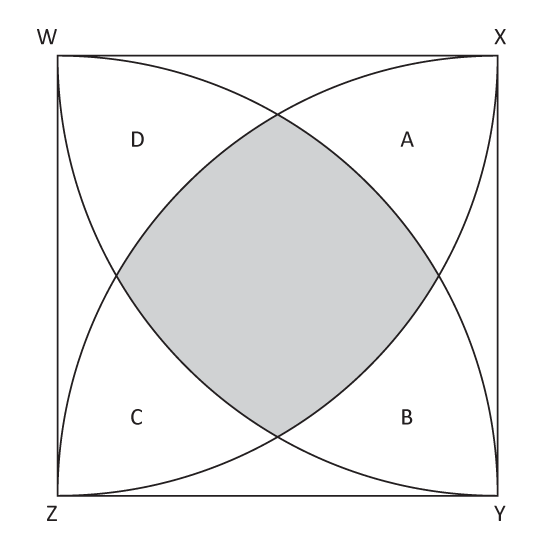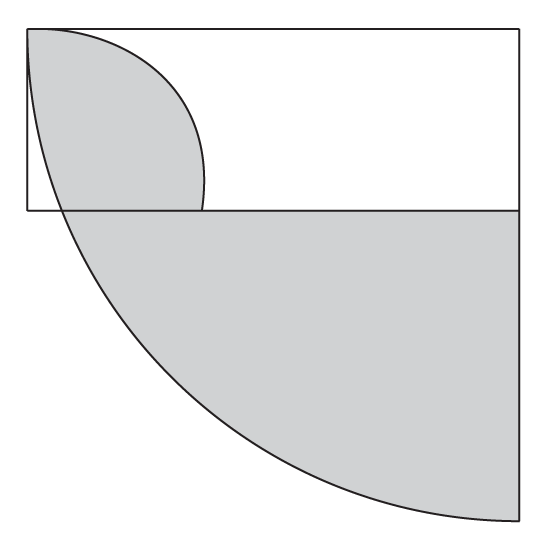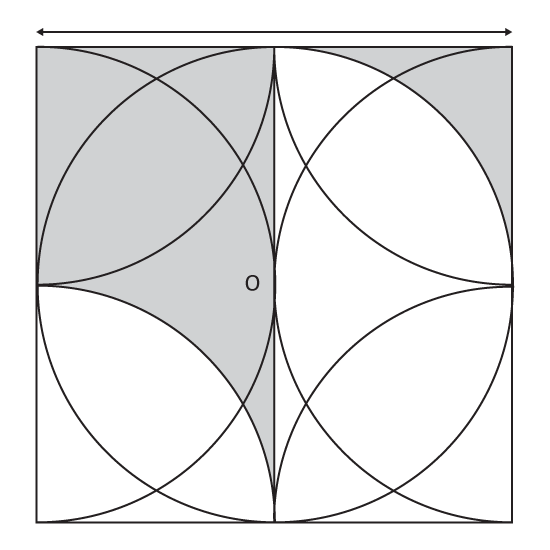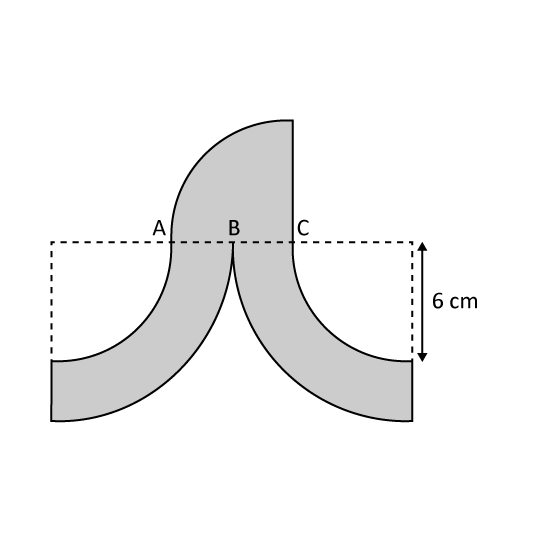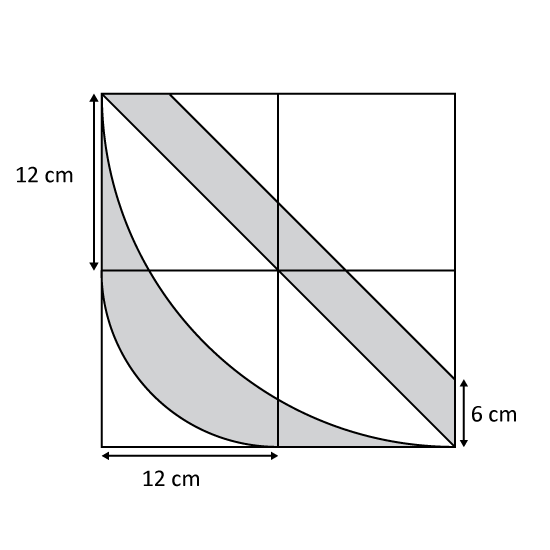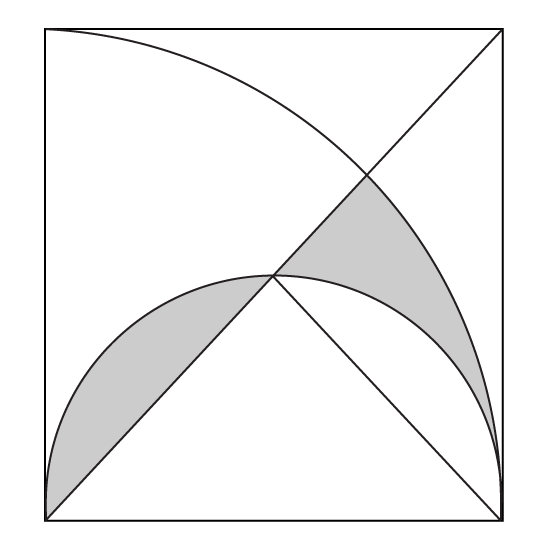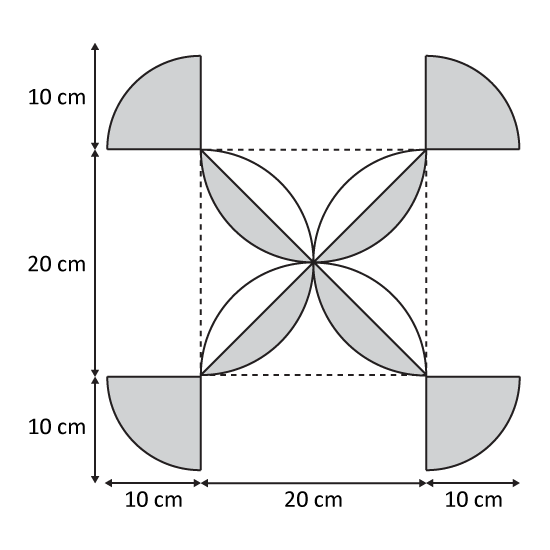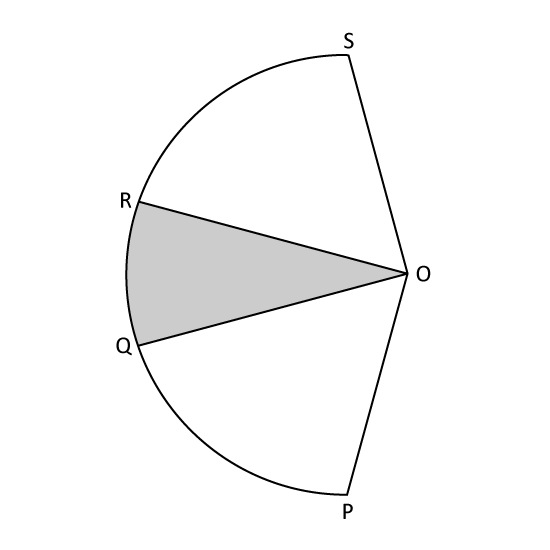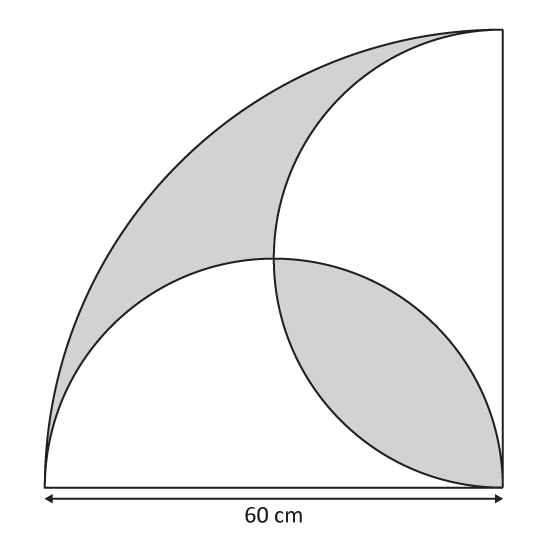Level 2
The figure is formed by 2 semicircles, 2 identical quarter circles and a square ABCD. The perimeter of square ABCD is 60 cm. What is the total area of the shaded parts? Express the answer in the nearest whole number. (Take π = 3.14)
Level 2
The figure is formed by 2 semicircles, 2 identical quarter circles and a square ABCD. The perimeter of square ABCD is 60 cm. What is the total area of the shaded parts? Express the answer in the nearest whole number. (Take π = 3.14)
Image in this question is not available.
Level 2
Find (a) the area and (b) the perimeter of the figure. (Take π = 227)
Level 2
Find (a) the area and (b) the perimeter of the figure. (Take π = 227)
Image in this question is not available.
Level 1
The figure is made up of a rectangle and a semi-circle. The diameter of the circle is 80 cm. Find the area of the shaded part. (Take π = 3.14)
Level 1
The figure is made up of a rectangle and a semi-circle. The diameter of the circle is 80 cm. Find the area of the shaded part. (Take π = 3.14)
Image in this question is not available.
Level 3 PSLE
LOPQ is a rectangular cardboard with LQ = 7 cm. Two quarter circles have been cut from it as shown. The remaining cardboard, which is the shaded part, has an area of 56 cm2. Using π = 227, find the length of MN.
Level 3 PSLE
LOPQ is a rectangular cardboard with LQ = 7 cm. Two quarter circles have been cut from it as shown. The remaining cardboard, which is the shaded part, has an area of 56 cm2. Using π = 227, find the length of MN.
Image in this question is not available.
Level 3
The figure shown is formed by cutting out three identical quadrants from three identical squares. Find the area of the figure. (Take π = 227)
Level 3
The figure shown is formed by cutting out three identical quadrants from three identical squares. Find the area of the figure. (Take π = 227)
Image in this question is not available.
Level 3
The figure shows 2 quarter circles and a rectangle. The radius of the big quarter circle is 10 cm. The radius of the small quarter circle is 5 cm. Find the difference in area between the two shaded parts P and Q. (Take π = 3.14 and give the answer correct to 1 decimal place)
Answer: 5.7 cm2
Level 3
The figure shows 2 quarter circles and a rectangle. The radius of the big quarter circle is 10 cm. The radius of the small quarter circle is 5 cm. Find the difference in area between the two shaded parts P and Q. (Take π = 3.14 and give the answer correct to 1 decimal place)
Answer: 5.7 cm2
Image in this question is not available.
Level 3
The figure shows a rectangle with 2 identical semicircles and quadrants within It. The length of the rectangle is 10 cm. Find the area of the shaded part. (Take π = 3.14)
Level 3
The figure shows a rectangle with 2 identical semicircles and quadrants within It. The length of the rectangle is 10 cm. Find the area of the shaded part. (Take π = 3.14)
Image in this question is not available.
Level 3
The figure consists of a rectangle, a quadrant and an isosceles triangle. Given that the radius of the quadrant is 10 cm and B is the midpoint of Line AC, find the difference between the shaded areas Y and Z. Express the answer in nearest whole number.
(Take π = 3.14)
Level 3
The figure consists of a rectangle, a quadrant and an isosceles triangle. Given that the radius of the quadrant is 10 cm and B is the midpoint of Line AC, find the difference between the shaded areas Y and Z. Express the answer in nearest whole number.
(Take π = 3.14)
Image in this question is not available.
Level 3
In the figure, WXYZ is a square of side 20 cm with a semi-circle and 2 quadrants drawn in it. Find the difference in areas of the shaded regions A and B.
(Take π = 3.14)
Level 3
In the figure, WXYZ is a square of side 20 cm with a semi-circle and 2 quadrants drawn in it. Find the difference in areas of the shaded regions A and B.
(Take π = 3.14)
Image in this question is not available.
Level 3
The figure shows two identical semi-circles. XY is a straight line. X and Y are the centres of the semi-circles. Given that the radius of the semi-circle is 10 cm, find the area of the shaded regions. Express the answer correct to 1 decimal place. (Take π = 3.14)
Level 3
The figure shows two identical semi-circles. XY is a straight line. X and Y are the centres of the semi-circles. Given that the radius of the semi-circle is 10 cm, find the area of the shaded regions. Express the answer correct to 1 decimal place. (Take π = 3.14)
Image in this question is not available.
Level 3
The figure is made up of curved lines (arcs) of quadrants with radius of different lengths in a square of edge 6 cm. Find the total shaded area. (Take π = 3.14)
Level 3
The figure is made up of curved lines (arcs) of quadrants with radius of different lengths in a square of edge 6 cm. Find the total shaded area. (Take π = 3.14)
Image in this question is not available.
Level 3
WXYZ is a square of side 14 cm. The shaded area is 64 cm2. Calculate the total areas of A, B, C and D. (Take π = 227).
Level 3
WXYZ is a square of side 14 cm. The shaded area is 64 cm2. Calculate the total areas of A, B, C and D. (Take π = 227).
Image in this question is not available.
Level 3
The figure is made of 2 quadrants and a rectangle. The rectangle measures 12 cm by 4 cm. Using the calculator value of π, find the area of the shaded part. Correct the answer to 2 decimal places.
Level 3
The figure is made of 2 quadrants and a rectangle. The rectangle measures 12 cm by 4 cm. Using the calculator value of π, find the area of the shaded part. Correct the answer to 2 decimal places.
Image in this question is not available.
Level 3
The figure is made up of a circle, 4 identical semi-circles and a square of side 14 cm. O is the centre of the circle. What is the area of the shaded figure?. (Take π = 227)
Level 3
The figure is made up of a circle, 4 identical semi-circles and a square of side 14 cm. O is the centre of the circle. What is the area of the shaded figure?. (Take π = 227)
Image in this question is not available.
Level 2 PSLE The outline of the shaded figure is formed by 3 identical small quarter circles, 2 identical large quarter circles and 3 straight lines. Take π = 3.14
- What is the radius of the large quarter circle?
- Find the perimeter of the shaded figure.
Level 2 PSLE The outline of the shaded figure is formed by 3 identical small quarter circles, 2 identical large quarter circles and 3 straight lines. Take π = 3.14
- What is the radius of the large quarter circle?
- Find the perimeter of the shaded figure.
Image in this question is not available.
Level 3
Willi noticed the patterns on the square tiles and tried to calculate the area of the shaded part. Leave the answer in 2 decimal places.
(Take π = 3.14)
Level 3
Willi noticed the patterns on the square tiles and tried to calculate the area of the shaded part. Leave the answer in 2 decimal places.
(Take π = 3.14)
Image in this question is not available.
Level 3
The figure is made up of a quadrant, a square and a semicircle. The area of the square is 144 cm2. Find the area of the shaded parts. (Take π = 3.14)
Level 3
The figure is made up of a quadrant, a square and a semicircle. The area of the square is 144 cm2. Find the area of the shaded parts. (Take π = 3.14)
Image in this question is not available.
Level 3
The figure is made up of identical quadrants. The radius is 10 cm long. Take π as 3.14.
- Find the area of the shaded part.
- Find the perimeter of the shaded part.
Level 3
The figure is made up of identical quadrants. The radius is 10 cm long. Take π as 3.14.
- Find the area of the shaded part.
- Find the perimeter of the shaded part.
Image in this question is not available.
Level 3 PSLE
OPQRS is part of a circle of radius 10 cm. OPR and OQS are quarter circles. The area of the shaded part OQR is 40 cm
2 and the perimeter of the shaded part OQR is 30 cm. For each of the following, use the calculator value of π to find:
- the area of the figure OPQRS, correct to 2 decimal places,
- the perimeter of the figure OPQRS, correct to 1 decimal places.
Level 3 PSLE
OPQRS is part of a circle of radius 10 cm. OPR and OQS are quarter circles. The area of the shaded part OQR is 40 cm
2 and the perimeter of the shaded part OQR is 30 cm. For each of the following, use the calculator value of π to find:
- the area of the figure OPQRS, correct to 2 decimal places,
- the perimeter of the figure OPQRS, correct to 1 decimal places.
Image in this question is not available.
Level 3
The figure shows one big quadrant and two small semicircles. The radius of the big quadrant is 60 cm.
- Find the perimeter of the shaded figure. (Take π = 3.14)
- Find the shaded area of this figure. (Take π = 3.14)
Level 3
The figure shows one big quadrant and two small semicircles. The radius of the big quadrant is 60 cm.
- Find the perimeter of the shaded figure. (Take π = 3.14)
- Find the shaded area of this figure. (Take π = 3.14)
Image in this question is not available.
